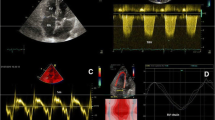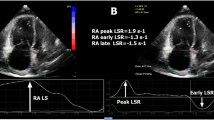Abstract
Background
Systemic sclerosis (SSc) is a systemic connective tissue disease and cardiac involvement is one of the most important causes of death. Right ventricular (RV) systolic dysfunction is a poor prognostic finding in SSc patients. Assessment of RV function has some difficulties because of its crescent shape and extensive trabeculations. Two-dimensional (2D) speckle-tracking echocardiography (STE) is an angle-independent quantitative technique to evaluate myocardial function. The aim of this study was to assess the RV and right atrial (RA) functions of SSc patients without pulmonary hypertension by using 2D STE.
Patients and methods
A total of 40 patients with SSc (mean age 48.5 ± 11.4 years, 28 female) and 40 healthy volunteers (mean age 45.9 ± 7.6 years, 21 female) were included in the study. All subjects underwent transthoracic echocardiography for evaluation of RV and RA functions with 2D STE.
Results
Although left ventricular systolic and diastolic functions, systolic pulmonary artery pressure (PAP), and RA measurements were similar in both groups, tricuspid annular plane systolic excursion (TAPSE) and maximum systolic myocardial velocity (S’) were decreased in SSc patients. The RV free wall global longitudinal strain (GLS) of SSc patients was lower than the controls (− 18.5 ± 4.9 % vs. − 21.8 ± 2.4 %, p < 0.001) and the RA reservoir and conduit functions were also decreased in SSc patients compared with controls (34.4 ± 9.9 % vs. 39.7 ± 11.2 %, p = 0.027 and 15.0 ± 5.7 % vs. 18.7 ± 6.4 %, p = 0.009, respectively). Disease duration was inversely correlated with RVGLS and TAPSE (r: − 0.416, p = 0.018 and r: − 0.383, p = 0.031, respectively).
Conclusion
The use of 2D STE can be helpful in the detection of impairment in RV and RA functions in SSc patients with normal PAP.
Zusammenfassung
Hintergrund
Die systemische Sklerose (SSc) ist eine systemische Bindegewebserkrankung, und die Herzbeteiligung stellt eine der Haupttodesursachen dar. Eine rechtsventrikuläre (RV) systolische Funktionseinschränkung ist ein Befund, der bei SSc-Patienten für eine schlechte Prognose steht. Die Untersuchung der RV-Funktion ist aufgrund der Halbmondform und ausgedehnter Trabekulierungen des RV schwierig. Die zweidimensionale (2-D-)Speckle-Tracking-Echokardiographie (STE) ist eine winkelunabhänigige quantitative Untersuchungstechnik für die Myokardfunktion. Ziel dieser Studie war es, die Funktion des RV und des rechten Vorhofs (RA) bei SSc-Patienten ohne pulmonale Hypertonie mittels 2-D-STE zu ermitteln.
Patienten und Methoden
In die Studie wurden 40 Patienten mit SSc (Durchschnittsalter: 48,5 ± 11,4 Jahre, 28 w) und 40 gesunde Kontrollen (Durchschnittsalter: 45,9 ± 7,6 Jahre, 21 w) aufgenommen. Bei allen Teilnehmern wurden die RV- und RA-Funktion mittels transthorakaler Echokardiographie in Kombination mit 2-D-STE untersucht.
Ergebnisse
Die linksventrikuläre systolische und diastolische Funktion, der systolische Pulmonalarteriendruck (PAP) und die RA-Messungen waren in beiden Gruppen zwar ähnlich, aber die systolische Exkursion auf der Ebene des Trikuspidalrings (TAPSE) und die maximale systolische Myokardgeschwindigkeit (S‘) waren bei SSc-Patienten vermindert. Der globale longitudinale Strain (GLS) der freien RV-Wand war bei SSc-Patienten geringer als bei den Kontrollen (− 18,5 ± 4,9 % vs. − 21,8 ± 2,4 %; p < 0,001) und auch die Reservoir- und Conduitfunktion war bei den SSc-Patienten gegenüber den Kontrollen vermindert (34,4 ± 9,9 % vs. 39,7 ± 11,2 %; p = 0,027 bzw. 15,0 ± 5,7 % vs. 18,7 ± 6,4 %; p = 0,009). Die Krankheitsdauer stand in inverser Korrelation mit dem RV-GLS und TAPSE (r − 0,416; p = 0,018 bzw. r − 0,383; p = 0,031).
Schlussfolgerung
Der Einsatz der 2-D-STE könnte zur Erkennung einer Einschränkung der RV- und RA-Funktion bei SSc-Patienten mit normalem PAP von Nutzen sein.


Similar content being viewed by others
References
Medsger TA Jr (2001) Systemic sclerosis (scleroderma): clinical aspects. In: Koopman WJ (ed) Arthritis and allied conditions: a textbook of rheumatology, 14th edn. Lippincott Williams & Wilkins, Philadelphia, pp 1590–1624
Komócsi A, Vorobcsuk A, Faludi R et al (2012) The impact of cardiopulmonary manifestations on the mortality of SSc: a systematic review and meta-analysis of observational studies. Rheumatology (Oxford) 51:1027–1036
Kahan A, Allanore Y (2006) Primary myocardial involvement in systemic sclerosis. Rheumatology (Oxford) 45(Suppl 4):iv14–iv17
Rudski LG, Lai WW, Afilalo J et al (2010) Guidelines for the echocardiographic assessment of the right heart in adults: a report from the American Society of Echocardiography endorsed by the European Association of Echocardiography, a registered branch of the European Society of Cardiology, and the Canadian Society of Echocardiography. J Am Soc Echocardiogr 23:685–713
Meris A, Faletra F, Conca C et al (2010) Timing and magnitude of regional right ventricular function: a speckle tracking-derived strain study of normal subjects and patients with right ventricular dysfunction. J Am Soc Echocardiogr 23:823–831
Masi AT, Rodnan GP, Medsger TA et al (1980) Subcommittee for scleroderma criteria of the American Rheumatism Association Diagnostic and Therapeutic Criteria Committee. Preliminary criteria for the classification of systemic sclerosis (scleroderma). Arthritis Rheum 23:581–590
Cheitlin MD, Armstrong WF, Aurigemma GP et al (2003) ACC/AHA/ASE 2003 guideline update for the clinical application of echocardiography: summary article. A report of the American College of Cardiology/American Heart Association Task Force on Practice Guidelines (ACC/AHA/ASE Committee to Update the 1997 Guidelines for the Clinical Application of Echocardiography). J Am Soc Echocardiogr 16:1091–1110
Sunbul M, Kepez A, Kivrak T et al (2013) Right ventricular longitudinal deformation parameters and exercise capacity. Herz. doi:10.1007/s00059-013-3842-y
Padeletti M, Cameli M, Lisi M et al (2012) Reference values of right atrial longitudinal strain imaging by two-dimensional speckle tracking. Echocardiography 29:147–152
Mor-Avi V, Lang RM, Badano LP et al (2011) Current and evolving echocardiographic techniques for the quantitative evaluation of cardiac mechanics: ASE/EAE consensus statement on methodology and indications endorsed by the Japanese Society of Echocardiography. Eur J Echocardiogr 12:167–205
Muangchan C, Canadian Scleroderma Research Group, Baron M, Pope J (2013) The 15 % rule in scleroderma: the frequency of severe organ complications in systemic sclerosis. A systematic review. J Rheumatol 40:1545–1556
Gelber AC, Manno RL, Shah AA et al (2013) Race and association with disease manifestations and mortality in scleroderma: a 20-year experience at the Johns Hopkins Scleroderma Center and review of the literature. Medicine (Baltimore) 92:191–205
Hsiao SH, Lee CY, Chang SM et al (2006) Right heart function in scleroderma: insights from myocardial Doppler tissue imaging. J Am Soc Echocardiogr 19:507–514
Pavlicek M, Wahl A, Rutz T et al (2011) Right ventricular systolic function assessment: rank of echocardiographic methods vs. cardiac magnetic resonance imaging. Eur J Echocardiogr 12:871–880
Lee CY, Chang SM, Hsiao SH et al (2007) Right heart function and scleroderma: insights from tricuspid annular plane systolic excursion. Echocardiography 24:118–125
Hardegree EL, Sachdev A, Fenstad ER et al (2013) Impaired left ventricular mechanics in pulmonary arterial hypertension: identification of a cohort at high risk. Circ Heart Fail 6:748–755
Cusmà Piccione M, Zito C, Bagnato G et al (2013) Role of 2D strain in the early identification of left ventricular dysfunction and in the risk stratification of systemic sclerosis patients. Cardiovasc Ultrasound 11:6
Spethmann S, Dreger H, Schattke S et al (2012) Two-dimensional speckle tracking of the left ventricle in patients with systemic sclerosis for an early detection of myocardial involvement. Eur Heart J Cardiovasc Imaging 13:863–870
Sunbul M, Durmus E, Kıvrak T et al (2013) Left ventricular strain and strain rate by two-dimensional speckle tracking echocardiography in patients with subclinical hypothyroidism. Eur Rev Med Pharmacol Sci 17:3323–3328
Tanboğa IH, Işık T, Kaya A et al (2012) Two-dimensional strain imaging to predict the localization of an accessory pathway. Turk Kardiyol Dern Ars 40:108
Stefani L, Pedrizzetti G, De Luca A et al (2009) Real-time evaluation of longitudinal peak systolic strain (speckle tracking measurement) in left and right ventricles of athletes. Cardiovasc Ultrasound 7:17
Simsek Z, Tas MH, Gunay E et al (2013) Speckle-tracking echocardiographic imaging of the right ventricular systolic and diastolic parameters in chronic exercise. Int J Cardiovasc Imaging 29:1265–1271
Altekin RE, Karakas MS, Yanikoglu A et al (2012) Determination of right ventricular dysfunction using the speckle tracking echocardiography method in patients with obstructive sleep apnea. Cardiol J 19:130–139
Padeletti M, Cameli M, Lisi M et al (2011) Right atrial speckle tracking analysis as a novel noninvasive method for pulmonary hemodynamics assessment in patients with chronic systolic heart failure. Echocardiography 28:658–664
Matias C, Isla LP, Vasconcelos M et al (2009) Speckle-tracking-derived strain and strain-rate analysis: a technique for the evaluation of early alterations in right ventricle systolic function in patients with systemic sclerosis and normal pulmonary artery pressure. J Cardiovasc Med (Hagerstown) 10:129–134
Schattke S, Knebel F, Grohmann A et al (2010) Early right ventricular systolic dysfunction in patients with systemic sclerosis without pulmonary hypertension: a Doppler tissue and speckle tracking echocardiography study. Cardiovasc Ultrasound 8:3. doi:10.1186/1476-7120-8-3
Kepez A, Sunbul M, Kivrak T et al (2014) Evaluation of improvement in exercise capacity after pulmonary endarterectomy in patients with chronic thromboembolic pulmonary hypertension: correlation with echocardiographic parameters. Thorac Cardiovasc Surg 62:60–65
Tedford RJ, Mudd JO, Girgis RE et al (2013) Right ventricular dysfunction in systemic sclerosis associated pulmonary arterial hypertension. Circ Heart Fail 6:953–963
Saraiva RM, Demirkol S, Buakhamsri A et al (2010) Left atrial strain measured by two-dimensional speckle tracking represents a new tool to evaluate left atrial function. J Am Soc Echocardiogr 2:172–180
Tsai WC, Lee CH, Lin CC et al (2009) Association of left atrial strain and strain rate assessed by speckle tracking echocardiography with paroxysmal atrial fibrillation. Echocardiography 26:1188–1194
Rosça M, Popescu BA, Beladan CC et al (2010) Left atrial dysfunction as a correlate of heart failure symptoms in hypertrophic cardiomyopathy. J Am Soc Echocardiogr 23:1090–1098
D’Andrea A, Caso P, Romano S et al (2009) Association between left atrial myocardial function and exercise capacity in patients with either idiopathic or ischemic dilated cardiomyopathy: a two-dimensional speckle strain study. Int J Cardiol 132:354–363
Compliance with ethical guidelines
Conflict of interest. E. Durmus, M. Sunbul, K. Tigen, T. Kivrak, G. Ozen, I. Sari, H. Direskeneli, and Y. Basaran state that there are no conflicts of interest. All studies on humans described in the present manuscript were carried out with the approval of the responsible ethics committee and in accordance with national law and the Helsinki Declaration of 1975 (in its current, revised form). Informed consent was obtained from all patients included in studies.
Author information
Authors and Affiliations
Corresponding author
Rights and permissions
About this article
Cite this article
Durmus, E., Sunbul, M., Tigen, K. et al. Right ventricular and atrial functions in systemic sclerosis patients without pulmonary hypertension. Herz 40, 709–715 (2015). https://doi.org/10.1007/s00059-014-4113-2
Received:
Revised:
Accepted:
Published:
Issue Date:
DOI: https://doi.org/10.1007/s00059-014-4113-2




